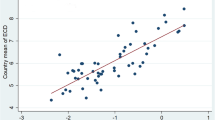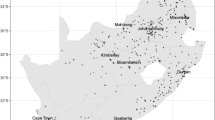Abstract
Background: This study was undertaken to determine the association between poor developmental attainment (PDA) and biological, home environment and socio-demographic factors in a population-based sample of Canadian children.
Methods: Cross-sectional data from two cycles (1994/95 and 1996/97) of the National Longitudinal Survey of Children and Youth were used. Children aged 1–5 years were included. PDA was defined as ≤15th percentile for motor and social developmental skills (1–3 year olds) or Peabody Picture Vocabulary Test (4–5 year olds). Multiple logistic regression was used.
Results: The proportion of children with PDA varies across Canada, between males and females, and by age. Among 1 year olds in Cycle I, having a low birthweight (OR=3.3; 95% CI: 2.1–5.2), being male (OR=1.6; 95% CI: 1.2–2.2) and having a mother who is an immigrant (OR=1.6; 95% CI: 1.1–2.2) increased the odds of PDA. Similar results were observed in Cycle II. Among children aged 4–5 years in Cycle II, having a mother who is an immigrant (OR=5.3; 95% CI: 4.1–6.9) and a mother with low educational attainment (OR=2.8; 95% CI: 2.1–3.9) increased the odds of PDA. Low income was a significant predictor of PDA across all age groups.
Interpretation: The strong and consistent associations with living in a low-income household, having a mother with low educational attainment or a mother who is an immigrant highlight the need for targeting developmental assessments and services to this population.
Résumé
Contexte: Cette étude a été effectuée pour évaluer les liens entre le niveau de développement (ND) et les facteurs biologiques, domestiques et socio-démographiques dans un échantillon représentatif d’enfants canadiens.
Méthode: Les données transversales de deux cycles (1994–1995 et 1996–1997) de l’Enquête longitudinale nationale sur les enfants et les jeunes ont été utilisées. Les enfants âgés de 1–5 ans ont été inclus. Un faible ND a été défini comme inférieur au 15e percentile pour les aptitudes de développement moteur et social (1–3 ans) ou selon le Test d’échelle vocabulaire en image Peabody (4–5 ans). La régression logistique multiple a été utilisée.
Résultats: La proportion d’enfants souffrant d’un faible ND varie d’une région à l’autre du Canada selon le sexe et l’âge. Chez les enfants de 1 an du Cycle I, le fait d’avoir un faible poids à la naissance (RC=3,3; IC de 95 % = 2,1–5,2), d’être un garçon (RC=1,6; IC de 95 % = 1,2–2,2) et d’avoir une mère immigrée (RC=1,6; IC de 95 % = 1,1–2,2) augmentaient le risque de présenter un faible ND. Les mêmes résultats ont été obtenus dans le Cycle II. Chez les enfants de 4–5 ans du Cycle II, le fait d’avoir une mère immigrée (RC=5,3; IC de 95 % = 4,1–6,9) et une mère avec un faible niveau d’études (RC=2,8; IC de 95 % = 2,1–3,9) augmentaient le risque de présenter un faible ND. Un foyer à faible revenu était un facteur de risque significatif de faible ND dans toutes les catégories d’âge.
Interprétation: Les liens forts et cohérents entre le fait de vivre dans un foyer à faible revenu, d’avoir une mère faiblement scolarisée et d’avoir une mère immigrée soulignent le besoin de cibler des contrôles et des services de développement pour ces enfants.
Similar content being viewed by others
References
Laucht M, Esser G, Schmidt MH, Ihle W, Loffler W, Stohr RM, et al. “Risk children”: The importance of biological and psychological risk for child development in the first two years of life [abstract]. Prax Kinderpsychol Kinderpsychiatr 1992;41:274–85.
Kochanek TT, Kabacoff RI, Lipsitt LP. Early identification of developmentally disabled and atrisk preschool children. Except Child 1990;56:528–38.
Health Canada, Human Resources Development Canada, and Indian and Northern Affairs Canada. Federal/Provincial/Territorial Early Childhood Development Agreement: Report on Government of Canada Activities and Expenditures 2000–2001: Minister of Public Works and Government Services Canada, 2001.
Human Resources Development Canada and Statistics Canada. National Longitudinal Survey of Children and Youth. User’s handbook and microdata guide. Cycle 1, release 2. Ottawa: Minister of Industry, 1997.
Human Resources Development Canada and Statistics Canada. National Longitudinal Survey of Children and Youth. User guide. Cycle 2, release 3. Ottawa: Minister of Industry, 1999.
Baker PC, Kech CK, Mott FL, Quinlan SV. NLSY child handbook - revised edition. A guide to the 1986–1990 National Longitudinal Survey of Youth - Child data. Columbus, Ohio: Center for Human Resource Research, The Ohio State University, 1993.
Mott FL, Baker PC, Ball DE, Keck CC, Lenhart SM. The NLSY children 1992: Description and evaluation - revised. Columbus, Ohio: Center for Human Resource Research, The Ohio State University, 1998.
Center for Human Resource Research. NLSY79 1996, Child and young adult data users guide. Columbus, Ohio: Center for Human Resource Research, The Ohio State University, 1998.
Dunn L, Dunn L. PPVT-Revised Manual. Circle Pines, MN: American Guidance Service, 1981.
Peterson JL, Moore KA. Motor and social development in infancy: Some results from a national survey. Washington, DC: Child Trends, 1987.
Radloff LS. The CES-D scale: A self-report depression scale for research in the general population. Applied Psychological Measurement 1977;1:385–404.
Landy S, Tam KK. Understanding the contribution of multiple risk factors on child development at various ages. Hull, Quebec: Applied Research Branch, Strategic Policy, Human Resources Development Canada, 1998;30.
Statistics Canada. Low Income Cut-Offs. Ottawa: Statistics Canada, 1996.
Ramey CT, Stedman DJ, Borders-Patterson A, Mengel W. Predicting school failure from information available at birth. Am J Ment Defic 1978;82:525–34.
Ramey CT, Ramey SL. Which children benefit the most from early intervention? Pediatrics 1994;94:1064–66.
Andrews H, Goldberg D, Wellen N, Pittman B, Struening E. Prediction of special education placement from birth certificate data. Am J Prev Med 1995;11:55–61.
Caughy MO, DiPietro JA, Strobino DM. Day-care participation as a protective factor in the cognitive development of low-income children. Child Dev 1994;65:457–71.
Holloman HA, Dobbins DR, Scott KG. The effect of biological and social risk factors on special education placement: Birth weight and maternal education as an example. Res Dev Disabil 1998;19:281–94.
Lyytinen P, Laakso ML, Poikkeus AM, Rita N. The development and predictive relations of play and language across the second year. Scand J Psychol 1999;40:177–86.
Hedges LV, Nowell A. Sex Differences in mental test scores, variability, and numbers of high-scoring individuals. Science 1995;269:41–45.
Prior M, Smart D, Sanson A, Oberklaid F. Sex differences in psychological adjustment from infancy to 8 years. J Am Acad Child Adolesc Psychiatry 1993;32:291–304.
Mustard CA, Mayer T, Black C, Postl B. Continuity of pediatric ambulatory care in a universally insured population. Pediatrics 1996;98:1028–34.
Kozyrskyj A, Mustard C, Derksen S. Considering the Health Care Needs of Children Living in Households Receiving Income Assistance in Manitoba. Family Services and Manitoba Health Pilot Project. Winnipeg: Manitoba Centre for Health Policy and Evaluation, Department of Community Health Sciences, Faculty of Medicine, University of Manitoba, 2000;113.
Childcare Resource and Research Unit. The Early Childhood Development Agreement: Provincial initiatives and spending allocations, 2001–2002. Centre for Urban and Community Studies, University of Toronto, 2002.
Author information
Authors and Affiliations
Additional information
Disclaimer: This analysis was based on the Statistics Canada master file National Longitudinal Survey of Children and Youth which contains anonymized data collected in the 1994/95 and 1996/97 Special Survey. All computations were prepared by the Population Health Sciences Program, Research Institute, The Hospital for Sick Children, Toronto, Ontario, Canada. The responsibility for the use and interpretation of these data is entirely that of the authors. The opinions expressed do not represent the views of Statistics Canada.
Acknowledgements: Funding for this project was made available through the National Health Research and Development Program (NHRDP grant no. 6606-06-1999/2590112). The Paediatric Outcomes Research Team is funded by The Hospital for Sick Children Foundation. Dr. Teresa To is supported by the Canadian Institutes of Health Research and the Ontario Ministry of Health and Long-Term Care through an Investigator Award. Dr. Paul Dick is supported by the Ontario Ministry of Health and Long-Term Care through a Career Scientist Award (#05239). Dr. Astrid Guttmann is supported by a Senior Research Fellowship from the Canadian Institutes of Health Research. The results and conclusions are those of the authors; no official endorsement by the Ministry of Health is intended or should be inferred.
Rights and permissions
About this article
Cite this article
To, T., Guttmann, A., Dick, P.T. et al. What Factors Are Associated with Poor Developmental Attainment in Young Canadian Children?. Can J Public Health 95, 258–263 (2004). https://doi.org/10.1007/BF03405127
Received:
Accepted:
Published:
Issue Date:
DOI: https://doi.org/10.1007/BF03405127




